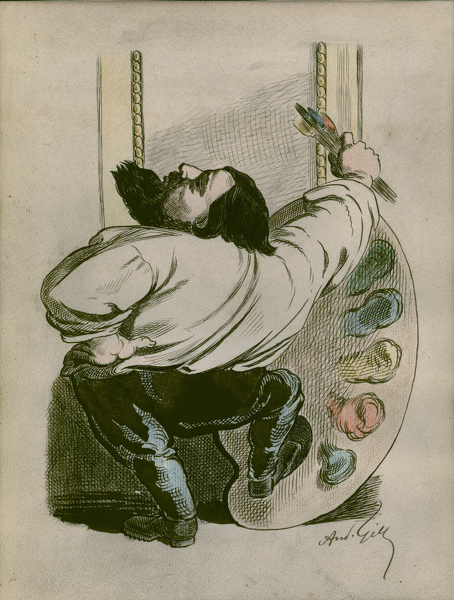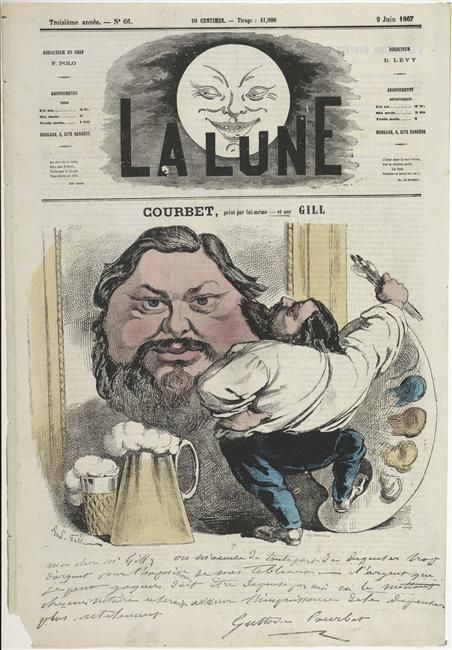
Caricature de Gustave COURBET à la colonne Vendôme
Framed (ref: 6634)
Signed,
Pen and ink, watercolour

Signed,
Pen and ink, watercolour
Provenance: The Artist's Studio
André Gill (1840-1885) was a French caricaturist. Born Louis-Alexandre Gosset de Guînes in Paris, he studied at the Royal Academy of Painting and Sculpture. Grosset adopted the pseudonym André Gill in homage to his hero, James Gillray (British political cartoonist, 1757-1815). He began his illustration career with "Le Journal Amusant" then worked for the weekly four-sheet newspaper "La Lune", from 1868 until 1876, edited by Francis Polo, for which he drew portraits for a series entitled The Man of the Day. Gill's style, which was subsequently much imitated, was noted for the enlargement of his subjects' heads, which sat upon undersized bodies. His caricatures, in the form of large hand-coloured, lithographic portraits, were considered very accurate and not very cruel. Thus, many of Gill's famous contemporaries wished to be drawn by him. Gill drew portrait caricatures of Sarah Bernhardt, Otto von Bismarck, Émile Zola, Victor Hugo, Nadar, Giuseppe Garibaldi, Adelina Patti, Charles Dickens, and Richard Wagner. As Napoleon III disliked the portrait of him drawn by Gill, in December 1867, La Lune was censored : "La Lune will have to undergo an eclipse," an authority commented to Polo when the ban was instituted, unwittingly dubbing his subsequent publication "L'éclipse" for which Gill also contributed caricatures. Subsequently, his fame won him entry into the Bohemian artistic world of Paris; Gill met Charles Cros, Paul Verlaine and Rimbaud. In 1870, Courbet established a "Federation of Artists" for the free and uncensored expansion of art of which Gill became a member. Other members included Honoré Daumier, Jean-Baptiste-Camille Corot, Eugène Pottier, Jules Dalou, and Manet.
In 1871, Courbet became an elected member of the Paris Commune (radical socialist and revolutionary government that ruled Paris from 18 March to 28 May 1871). Having previously expressed his dismay for "la Colonne Vendôme" (the obelisk which throughout the 19th century was seen as the most important symbol of Paris, located on the rue de la Paix), Courbet proposed that the column be disassembled and preserved at the Hôtel des Invalides (museum of the military history of France, hospital and retirement home for war veterans). Courbet argued that "la Colonne Vendôme", monument to war, devoid of all artistic value, perpetuated through it's expression the ideals of the past imperial dynasty.
The project as proposed was not adopted, though on 12 April 1871, legislation was passed authorising the dismantling of the imperial symbol by the National Defense Government . On May 16th 1871, observers saw that the statue fall over on the heap of sand prepared for it, with a mighty crash. Laying on the ground as a mass of ruins, whilst the dust and smoke from the stones and crumpled clay rose up, a crowd of men, National Guards, Communards, and a sight-seeing Englishman flew upon it, and commenced to get bits of it as remembrance, but the excitement was so intense that people moved about as in a dream.
The column was however restored and re-erected in 1873 and a court case directed the costs for this, to Courbet himself, though he died before the payment could be made.
This is the original watercolour for the cover of La Lune, 9 juin 1867.

The cover of La Lune - June 1867